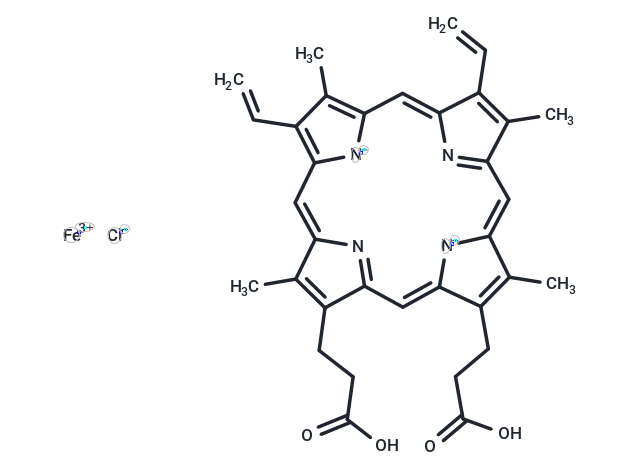Shopping Cart
- Remove All
 Your shopping cart is currently empty
Your shopping cart is currently empty

Hemin (Hemin chloride) is a chlorinated iron-containing porphyrin, a heme oxygenase (HO)-1 inducer. Hemin has therapeutic activity in porphyrias by reducing heme deficiency in patients, thereby inhibiting δ-aminolevulinic acid synthetase activity through biochemical feedback.

| Pack Size | Price | Availability | Quantity |
|---|---|---|---|
| 500 mg | $30 | In Stock | |
| 1 g | $40 | In Stock | |
| 5 g | $50 | Backorder |
| Description | Hemin (Hemin chloride) is a chlorinated iron-containing porphyrin, a heme oxygenase (HO)-1 inducer. Hemin has therapeutic activity in porphyrias by reducing heme deficiency in patients, thereby inhibiting δ-aminolevulinic acid synthetase activity through biochemical feedback. |
| In vitro | METHODS: Pancreatic cancer cells PA-TU-8902, BxPC-3 and MiaPaCa-2 were treated with Hemin (30 µM) for 48 h. Cell viability was measured using the CellTiter-Glo Luminescent Cell Viability Assay. RESULTS: Hemin had a significant effect on cell proliferation of PA-TU-8902, BxPC-3 and MiaPaCa-2 cell lines, decreasing cell proliferation to 62±5%, 51±3% and 38±8%, respectively. [1] METHODS: Astrocyte cultures were treated with Hemin (25 µM) for 12-24 h. Iron content was measured using colorimetric method. RESULTS: Iron accumulation occurred in cultured astrocytes after incubation with Hemin. [2] |
| In vivo | METHODS: To investigate the effects on renal injury, Hemin (100 µmol/kg) was administered intraperitoneally to BABL/c mice with renal ischemia-reperfusion. RESULTS: Hemin pretreatment promoted ERK1/2 phosphorylation and enhanced tubular recovery, thereby preventing further kidney injury. [3] METHODS: To investigate the effects on insulin resistance, Hemin (50 µmol/kg) was administered intraperitoneally to C57BL/6 mice on a high-fat diet once daily for four weeks. RESULTS: Hemin prevented the development of high-fat diet-induced insulin resistance by increasing insulin sensitivity in skeletal muscle. [4] |
| Cell Research | In vitro effects of various statins and hemin, a heme oxygenase inducer, on cell proliferation were evaluated in PA-TU-8902, MiaPaCa-2 and BxPC-3 human pancreatic cancer cell lines. The effect of statins on heme oxygenase activity was assessed and heme oxygenase-silenced cells were used for pancreatic cancer cell proliferation studies. Cell death rate and reactive oxygen species production were measured in PA-TU-8902 cells, followed by evaluation of the effect of cerivastatin on GFP-K-Ras trafficking and expression of markers of invasiveness, osteopontin (SPP1) and SOX2[1]. |
| Alias | Hemin chloride |
| Molecular Weight | 651.94 |
| Formula | C34H32ClFeN4O4 |
| Cas No. | 16009-13-5 |
| Smiles | [Cl-].[Fe+3].Cc1c(CCC(O)=O)c2cc3[n-]c(cc4nc(cc5[n-]c(cc1n2)c(C=C)c5C)c(C=C)c4C)c(C)c3CCC(O)=O |
| Relative Density. | no data available |
| Storage | keep away from direct sunlight | Powder: -20°C for 3 years | In solvent: -80°C for 1 year | Shipping with blue ice. |
| Solubility Information | 0.05%DMSO+99.95% 0.1 mM NaoH: 0.33 mg/mL (0.51 mM), In vivo: Please add co-solvents sequentially, clarifying the solution as much as possible before adding the next one. Dissolve by heating and/or sonication if necessary. Working solution is recommended to be prepared and used immediately. DMSO: < 1 mg/ml 0.05%DMSO+99.95%PBS: 0.33 mg/mL (0.51 mM), In vivo: Please add the solvents sequentially, clarifying the solution as much as possible before adding the next one. Dissolve by heating and/or sonication if necessary. Working solution is recommended to be prepared and used immediately. |

Copyright © 2015-2025 TargetMol Chemicals Inc. All Rights Reserved.